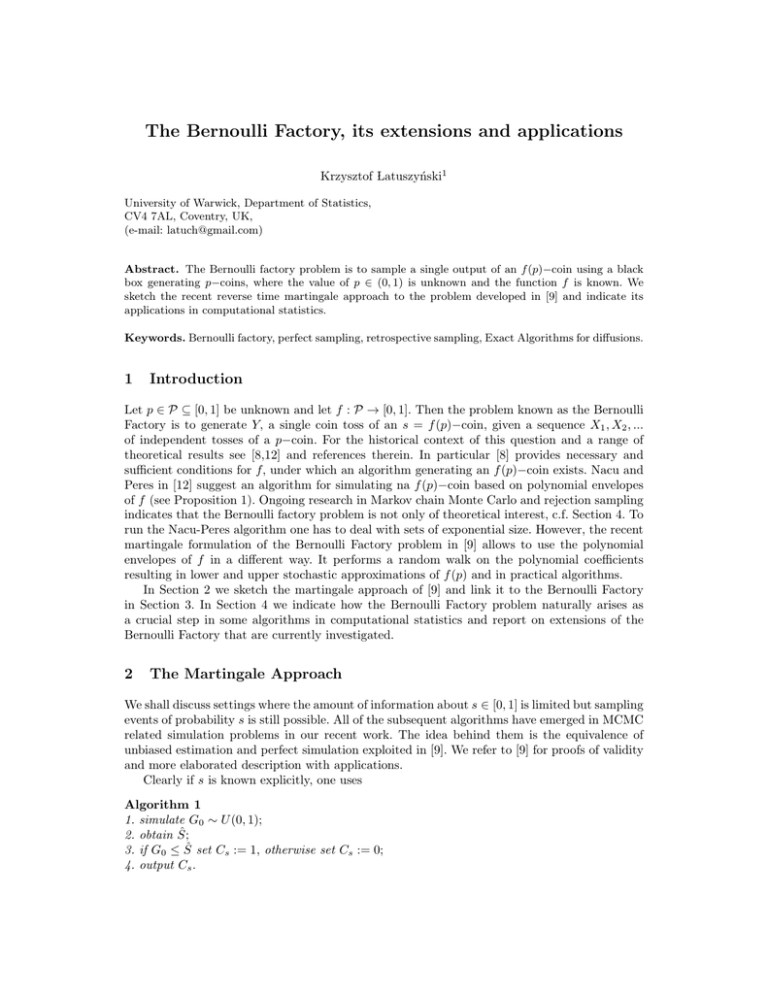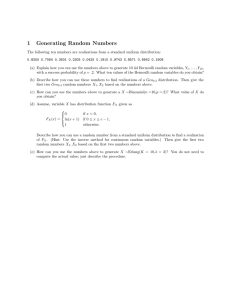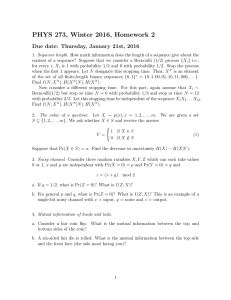The Bernoulli Factory, its extensions and applications Krzysztof Latuszy´ nski
advertisement

The Bernoulli Factory, its extensions and applications
Krzysztof Latuszyński1
University of Warwick, Department of Statistics,
CV4 7AL, Coventry, UK,
(e-mail: latuch@gmail.com)
Abstract. The Bernoulli factory problem is to sample a single output of an f (p)−coin using a black
box generating p−coins, where the value of p ∈ (0, 1) is unknown and the function f is known. We
sketch the recent reverse time martingale approach to the problem developed in [9] and indicate its
applications in computational statistics.
Keywords. Bernoulli factory, perfect sampling, retrospective sampling, Exact Algorithms for diffusions.
1
Introduction
Let p ∈ P ⊆ [0, 1] be unknown and let f : P → [0, 1]. Then the problem known as the Bernoulli
Factory is to generate Y, a single coin toss of an s = f (p)−coin, given a sequence X1 , X2 , ...
of independent tosses of a p−coin. For the historical context of this question and a range of
theoretical results see [8,12] and references therein. In particular [8] provides necessary and
sufficient conditions for f, under which an algorithm generating an f (p)−coin exists. Nacu and
Peres in [12] suggest an algorithm for simulating na f (p)−coin based on polynomial envelopes
of f (see Proposition 1). Ongoing research in Markov chain Monte Carlo and rejection sampling
indicates that the Bernoulli factory problem is not only of theoretical interest, c.f. Section 4. To
run the Nacu-Peres algorithm one has to deal with sets of exponential size. However, the recent
martingale formulation of the Bernoulli Factory problem in [9] allows to use the polynomial
envelopes of f in a different way. It performs a random walk on the polynomial coefficients
resulting in lower and upper stochastic approximations of f (p) and in practical algorithms.
In Section 2 we sketch the martingale approach of [9] and link it to the Bernoulli Factory
in Section 3. In Section 4 we indicate how the Bernoulli Factory problem naturally arises as
a crucial step in some algorithms in computational statistics and report on extensions of the
Bernoulli Factory that are currently investigated.
2
The Martingale Approach
We shall discuss settings where the amount of information about s ∈ [0, 1] is limited but sampling
events of probability s is still possible. All of the subsequent algorithms have emerged in MCMC
related simulation problems in our recent work. The idea behind them is the equivalence of
unbiased estimation and perfect simulation exploited in [9]. We refer to [9] for proofs of validity
and more elaborated description with applications.
Clearly if s is known explicitly, one uses
Algorithm 1
1. simulate G0 ∼ U (0, 1);
2. obtain Ŝ;
3. if G0 ≤ Ŝ set Cs := 1, otherwise set Cs := 0;
4. output Cs .
2
Krzysztof Latuszyński
Next assume that real valued monotone sequences ln % s and un & s are available.
Algorithm 2
1. simulate G0 ∼ U (0, 1); set n = 1;
2. compute ln and un ;
3. if G0 ≤ ln set Cs := 1;
4. if G0 > un set Cs := 0;
5. if ln < G0 ≤ un set n := n + 1 and GOTO 2;
6. output Cs .
The next step is to combine the above ideas and work with randomized bounds, i.e. in a
setting where we have estimators Ln and Un of the upper and lower bounds ln and un . The
estimators shall live on the same probability space and have the following properties.
P(Ln ≤ Un ) = 1
for every
n = 1, 2, ...
P(Ln ∈ [0, 1]) = 1 and P(Un ∈ [0, 1]) = 1
Let
(1)
for every n = 1, 2, ...
(2)
E Ln = ln % s and E Un = un & s
(3)
P(Ln−1 ≤ Ln ) = 1 and P(Un−1 ≥ Un ) = 1
(4)
F0 = {∅, Ω},
Fn = σ{Ln , Un },
Fk,n = σ{Fk , Fk+1 , ...Fn }
for k ≤ n.
Under these assumptions one can use the following algorithm.
Algorithm 3
1. simulate G0 ∼ U (0, 1); set n = 1;
2. obtain Ln and Un given F0,n−1 ,
3. if G0 ≤ Ln set Cs := 1;
4. if G0 > Un set Cs := 0;
5. if Ln < G0 ≤ Un set n := n + 1 and GOTO 2;
6. output Cs .
The final step is to weaken condition (4) and let Ln be a reverse time supermartingale and Un
a reverse time submartingale with respect to Fn,∞ . Precisely, assume that we have
E (Ln−1 | Fn,∞ ) = E (Ln−1 | Fn ) ≤ Ln a.s.
and
(5)
E (Un−1 | Fn,∞ ) = E (Un−1 | Fn ) ≥ Un a.s.
for every n = 1, 2, ...
(6)
The following algorithm uses auxiliary random sequences L̃n and Ũn constructed online.
Algorithm 4
1. simulate G0 ∼ U (0, 1); set n = 1; set L0 ≡ L̃0 ≡ 0 and U0 ≡ Ũ0 ≡ 1
2. obtain Ln and Un given F0,n−1 ,
3. compute L∗n = E (Ln−1 | Fn ) and Un∗ = E (Un−1 | Fn ).
4. compute
Un∗ − Un Ln − L∗n Ũ
−
L̃
Ũ
:=
Ũ
−
Ũ
−
L̃
L̃n := L̃n−1 + ∗
n−1
n−1
n
n−1
n−1
n−1
Un − L∗n
Un∗ − L∗n
5.
6.
7.
8.
if G0 ≤ L̃n set Cs := 1;
if G0 > Ũn set Cs := 0;
if L̃n < G0 ≤ Ũn set n := n + 1 and GOTO 2;
output Cs .
The Bernoulli Factory
3
3
Application to the Bernoulli Factory Problem
Here the following minor modification of Proposition 3 in [12] is reproved in a way that links
polynomial envelopes of f with the framework of Section 2 by identifying terms. It results in an
immediate application of Algorithm 4 and in practical algorithms. See [9] for more details.
Proposition 1. An algorithm that simulates a function f on P ⊆ (0, 1) exists if and only if for
all n ≥ 1 there exist polynomials gn (p) and hn (p) of the form
gn (p) =
n X
n
a(n, k)pk (1 − p)n−k
k
and
hn (p) =
k=0
n X
n
b(n, k)pk (1 − p)n−k ,
k
k=0
s.t. (i) 0 ≤ a(n, k) ≤ b(n, k) ≤ 1, (ii) limn→∞ gn (p) = f (p) = limn→∞ hn (p), (iii) For all
m < n, their coefficients satisfy
n−m m
n−m m
k
k
X
X
k−i
k−i
i
i b(m, i).
a(m, i),
b(n, k) ≤
(7)
a(n, k) ≥
n
n
i=0
k
i=0
k
Proof. We focus on proving polynomials ⇒ algorithm using framework of Section 2. Let X1 , X2 , . . .
be a sequence
Pn of independent tosses of a p−coin. Define random sequences {Ln , Un }n≥1 as follows: if i=1 Xi = k, then let Ln = a(n, k) and Un = b(n, k). In the rest of the proof we check
that (1), (2), (3), (5) and (6) hold for {Ln , Un }n≥1 with s = f (p). Thus executing Algorithm 4
with {Ln , Un }n≥1 yields a valid f (p)−coin.
Clearly (1) and (2) hold due to (i). For (3) note that E Ln = gn (p) % f (p) and E Un =
hn (p) & f (p). To obtain (5) and (6) definePthe sequence of random variables Hn to be the
n
number of heads in {X1 , . . . , Xn }, i.e. Hn = i=1 Xi and let Gn = σ(Hn ). Thus Ln = a(n, Hn )
and Un = b(n, Hn ), hence Fn ⊆ Gn and it is enough to check that E(Lm |Gn ) ≤ Ln and
E(Um |Gn ) ≥ Un for m < n. The distribution of Hm given Hn is hypergeometric and
E(Lm |Gn ) = E(a(m, Hm )|Hn ) =
Hn
X
i=0
n−m m
Hn −i
i
n
Hn
a(m, i) ≤ a(n, Hn ) = Ln .
Clearly the distribution of Hm given Hn is the same as the distribution of Hm given {Hn , Hn+1 , . . . }.
The argument for Un is identical.
4
Closing Remarks
The setting of Section 2, where s is uniquely determined but its exact computation is not
possible, has been encountered in various computational contexts. In particular Algorithm 2
has emerged as an element of more complex procedures in Exact Algorithms for diffusions in
[4,5,13], and the version of Exact Algorithm introduced in [3] can be obtained as an application
of Algorithm 3, c.f. [9]. The Bernoulli Factory has possible applications to regenerative MCMC
simulation (c.f. [1], [7], Chapter 16 of [2]). Moreover it appears unavoidable in certain settings
of exact MCMC algorithms for parameter inference in diffusions (c.f. [6,10]).
On the technical side, [9] indicates that for some functions with alternating series expansion,
there is no need of Algorithm 4 and Algorithm 3 can be applied resulting in a critical efficiency
improvement. This has been further investigated in [11] relating applicability of Algorithm 3
to completely monotone functions. Moreover [11] investigates the multivariate version of the
Bernoulli Factory problem by extending the martingale approach.
4
Krzysztof Latuszyński
References
[1] Assmussen, S., Glynn P. W. and Thorisson H. (1992): Stationarity detection in the initial transient
problem. ACM Transactions on Modelling and Computer Simulation. 2(2), 130-157.
[2] Asmussen S. and Glynn P. W. (2007): Stochastic simulation: algorithms and analysis. Springer, New
York.
[3] Beskos, A. and Roberts, G.O. (2005): Exact Simulation of Diffusions. Ann. Appl. Probab. 15(4),
2422–2444.
[4] Beskos, A., Papaspiliopoulos, O. and Roberts, G.O. (2008): A factorisation of diffusion measure and
finite sample path constructions. Methodol. Comput. Appl. Probab. 10(1), 85–104.
[5] Beskos, A., Papaspiliopoulos, O., Roberts, G.O. and Fearnhead, P. (2006): Exact and computationally
effcient likelihood-based estimation for discretely observed diffusion processes (with discussion).
Journal of the Royal Statistical Society: Series B (Statistical Methodology), 68(3), 333-382.
[6] Gonçalves, F.B., Latuszyński, K., Roberts G.O. (2010): Exact MCMC inference for log Gaussian
Cox process. In preparation.
[7] Henderson S.G. and P. W. Glynn P. W.(2003): Non-existence of a class of variate generation schemes.
Operations Research Letters, 31, 83–89.
[8] Keane, M.S. and OBrien, G.L. (1994): A Bernoulli factory. ACM Transactions on Modeling and
Computer Simulation (TOMACS), 4(2), 213-219.
[9] Latuszyński, K. , Kosmidos, I., Papaspiliopoulos, O. and Roberts, G. O. (2009): Simulating Events
of Unoknown Probabilities via Reverse Time Martingales. Random Structures and Algorithms, to
appear.
[10] Latuszyński, K., Palczewski, J. and Roberts G.O. (2010): Exact MCMC inference for a Markov
switching diffusion models with discreetly observed data. In preparation.
[11] Latuszyński, K., Papaspiliopoulos, O., Roberts, G. O. and Spano, D. (2010): Beyond the Bernoulli
Factory. In preparation.
[12] Nacu, S. and Peres, Y. (2005): Fast simulation of new coins from old. Annals of Applied Probability,
15(1), 93–115.
[13] Papaspiliopoulos, O. and Roberts, G.O. (2008): Retrospective Markov chain Monte Carlo for Dirichlet process hierarchical models. Biometrika, 95, 169–186.





